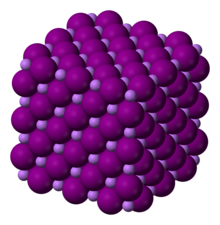Lithium iodide
 | |

| |
| Identifiers | |
|---|---|
| |
3D model (
JSmol ) |
|
| ChemSpider | |
ECHA InfoCard
|
100.030.735 |
PubChem CID
|
|
| UNII |
|
CompTox Dashboard (EPA)
|
|
| |
| |
| Properties | |
| LiI | |
| Molar mass | 133.85 g/mol |
| Appearance | White crystalline solid |
| Density | 4.076 g/cm3 (anhydrous) 3.494 g/cm3 (trihydrate) |
| Melting point | 469 °C (876 °F; 742 K) |
| Boiling point | 1,171 °C (2,140 °F; 1,444 K) |
| 1510 g/L (0 °C) 1670 g/L (25 °C) 4330 g/L (100 °C) [1] | |
| Solubility | soluble in ethanediol, ammonia
|
| Solubility in methanol | 3430 g/L (20 °C) |
| Solubility in acetone | 426 g/L (18 °C) |
| −50.0·10−6 cm3/mol | |
Refractive index (nD)
|
1.955 |
| Thermochemistry | |
Heat capacity (C)
|
0.381 J/g K or 54.4 J/mol K |
Std molar
entropy (S⦵298) |
75.7 J/mol K |
Std enthalpy of (ΔfH⦵298)formation |
-2.02 kJ/g or −270.48 kJ/mol |
Gibbs free energy (ΔfG⦵)
|
-266.9 kJ/mol |
| Hazards | |
| NFPA 704 (fire diamond) | |
| Flash point | Non-flammable |
| Safety data sheet (SDS) | External MSDS |
| Related compounds | |
Other anions
|
Lithium fluoride Lithium chloride Lithium bromide Lithium astatide |
Other cations
|
Francium iodide
|
Except where otherwise noted, data are given for materials in their standard state (at 25 °C [77 °F], 100 kPa).
| |
Lithium iodide, or LiI, is a
oxidation of iodide to iodine.[2] It crystallizes in the NaCl motif.[3] It can participate in various hydrates.[4]
Applications

Lithium iodide is used as a
artificial pacemakers[6] due to the long cycle life it enables.[7] The solid is used as a phosphor for neutron detection.[8] It is also used, in a complex with Iodine, in the electrolyte of dye-sensitized solar cells
.
In organic synthesis, LiI is useful for cleaving C-O bonds. For example, it can be used to convert methyl esters to carboxylic acids:[9]
- RCO2CH3 + LiI → RCO2Li + CH3I
Similar reactions apply to epoxides and aziridines.
Lithium iodide was used as a
organoiodine compounds.[10]
See also
References
- ISBN 0-07-049439-8
- ^ "Lithium iodide" (PDF). ESPI Corp. MSDS. Archived from the original (PDF) on 2008-03-09. Retrieved 2005-09-16.
- ISBN 0-19-855370-6.
- .
- PMID 26228378.
- S2CID 138189063.
- ^ Hanif, Maryam (2008). "The Pacemaker Battery - Review Article". UIC Bioengineering Student Journal.
- .
- PMID 23210836.
External links
Wikimedia Commons has media related to Lithium iodide.
- "WebElements – Lithium Iodide". Retrieved 2005-09-16.
- "Composition of Lithium Iodide – NIST". Retrieved 2006-02-03.

